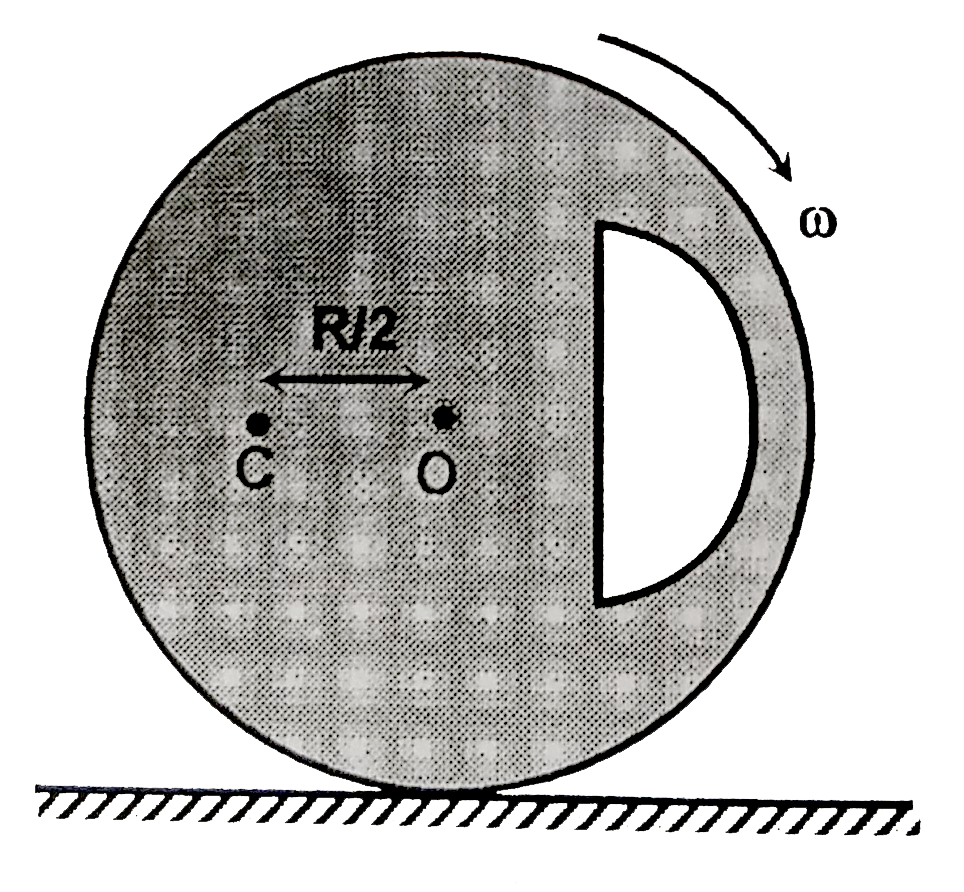The radius of gyration of a uniform disc about a line perpendicular to the disc equals ilts radius. Find the distance of the line from the centre.
To solve the problem, we need to find the distance d from the center of a uniform disc to a line perpendicular to the disc such that the radius of gyration about that line equals the radius of the disc r.
1. Understanding the Moment of Inertia of the Disc:
The moment of inertia I of a uniform disc about an axis through its center and perpendicular to its plane is given by:
I=12Mr2
where M is the mass of the disc and r is its radius.
2. Using the Parallel Axis Theorem:
When we want to find the moment of inertia about a line that is a distance d away from the center, we use the parallel axis theorem:
I′=I+Md2
where I′ is the moment of inertia about the new axis, I is the moment of inertia about the center, and d is the distance from the center to the new axis.
3. Setting Up the Equation:
According to the problem, the radius of gyration k about the new axis is equal to the radius r of the disc. The radius of gyration is related to the moment of inertia by the formula:
k=√I′M
Thus, we can write:
r=√I′M
Squaring both sides gives:
r2=I′M
Therefore, we can express I′ as:
I′=Mr2
4. Substituting for I′:
Now we can substitute the expression for I′ into the equation from the parallel axis theorem:
Mr2=12Mr2+Md2
5. Simplifying the Equation:
Dividing through by M (assuming M≠0):
r2=12r2+d2
Rearranging gives:
d2=r2−12r2=12r2
6. Finding d:
Taking the square root of both sides, we find:
d=√12r=r√2
Final Answer:
The distance d from the center of the disc to the line is:
d=r√2
The moment of inertia I of a uniform disc about an axis through its center and perpendicular to its plane is given by:
I=12Mr2
where M is the mass of the disc and r is its radius.
When we want to find the moment of inertia about a line that is a distance d away from the center, we use the parallel axis theorem:
I′=I+Md2
where I′ is the moment of inertia about the new axis, I is the moment of inertia about the center, and d is the distance from the center to the new axis.
According to the problem, the radius of gyration k about the new axis is equal to the radius r of the disc. The radius of gyration is related to the moment of inertia by the formula:
k=√I′M
Thus, we can write:
r=√I′M
Squaring both sides gives:
r2=I′M
Therefore, we can express I′ as:
I′=Mr2
Now we can substitute the expression for I′ into the equation from the parallel axis theorem:
Mr2=12Mr2+Md2
Dividing through by M (assuming M≠0):
r2=12r2+d2
Rearranging gives:
d2=r2−12r2=12r2
Taking the square root of both sides, we find:
d=√12r=r√2
The distance d from the center of the disc to the line is:
d=r√2
Topper's Solved these Questions
- ROTATIONAL MECHANICSBOOK - DC PANDEY ENGLISHCHAPTER - ROTATIONAL MECHANICSEXERCISE - Level 2 Single Correct
26 Videos
- ROTATIONAL MECHANICSBOOK - DC PANDEY ENGLISHCHAPTER - ROTATIONAL MECHANICSEXERCISE - Level 2 Multiple Correct
36 Videos
- ROTATIONAL MECHANICSBOOK - DC PANDEY ENGLISHCHAPTER - ROTATIONAL MECHANICSEXERCISE - Level 1 Objective
30 Videos
- ROTATIONBOOK - DC PANDEY ENGLISHCHAPTER - ROTATIONEXERCISE - (C) Chapter Exercises
39 Videos
- ROTATIONAL MOTIONBOOK - DC PANDEY ENGLISHCHAPTER - ROTATIONAL MOTIONEXERCISE - Integer Type Questions
17 Videos
Similar Questions
The radius of gyration of a uniform disc about a line perpendicular to the disc equals to its radius. Find the distance of the line from the centre.
View SolutionThe radius of gyration of a uniform rod of mass m and length l about an axis perpendicular to its length and at distance l4 from its centre will be
View Solution
Knowledge Check
The radius of gyration of a solid sphere of radius R about a certain axis is also equal to R. If r is the distance between the axis and the centre of the sphere, then r is equal to
ARB0.5RC√0.6RD√0.3R
Calculate the radius of gyration of a circular disc about its diameter.
View SolutionCalculate the radius of gyration of a circular disc about its diameter.
View SolutionFind the radius of gyration of a circular ring of radius r about a line perpendicular to the plane of the ring and passing through one of this particles.
View SolutionThe moment of inertia of a uniform semicircular disc of mass M and radius r about a line perpendicular to the plane of the disc through the center is
View SolutionThe radius of gyration of a solid shapere of radius r about a certain axis is r. The distance of this axis from the centre of the shpere is
View SolutionThe moment of inertia of a uniform semicircularwire of mass M and radius r about a line perpendicular to the plane of the wire through the centre is :
View SolutionA disc shaped body (having a hole shown in the figure) of mass m=10kg and radius R=109m is performing pure rolling motion on a rough horizontal surface. In the figure point O is geometrical center of the disc and at this instant the centre of mass C of the disc is at same horizontal level with O. The radius of gyration of the disc about an axis pasing through C and perpendicular to the plane of the disc is R2 and at the insant shown the angular velocity of the disc is ω=√gR rad/sec in clockwise sence. g is gravitation acceleration =10m/s2. Find angular acceleation α ( in rad/s2) of the disc at this instant.

View Solution
